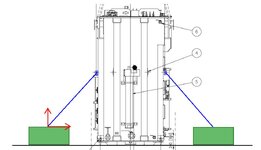structeng2
Structural
- Apr 18, 2016
- 38
Hello -
A client has a piece of equipment that is going to be stored on site for about 1 year before installation. They would like it to be temporarily anchored until then. We are exploring using concrete blocks (deadman block, eco block, etc) with weights around 3-4kips per block. The equipment would be fastened to the blocks with a cable at approximately 45deg.
My questions are about the load combinations, stability, and inertial forces of the blocks themselves.
Thanks!
A client has a piece of equipment that is going to be stored on site for about 1 year before installation. They would like it to be temporarily anchored until then. We are exploring using concrete blocks (deadman block, eco block, etc) with weights around 3-4kips per block. The equipment would be fastened to the blocks with a cable at approximately 45deg.
My questions are about the load combinations, stability, and inertial forces of the blocks themselves.
- Inertial Forces: Considering the block is above grade, it will be excited during a seismic event. This would reduce the blocks capacity to resist loading from the equipment. If the block was embedded, we would ignore inertial forces (just like we do for a regular foundation), however, I am not sure how to get around this when the block is sitting on grade.
- Load Combos/Stability: For stability, the controlling load combo will be 0.6D + 0.7Eh - 0.7Ev. This reduces the blocks self-weight even further, but again - I don't see a way around it.
Thanks!

